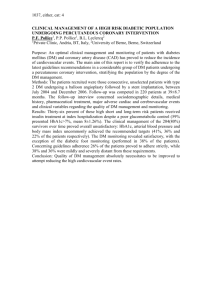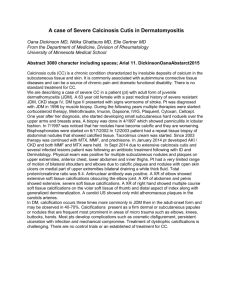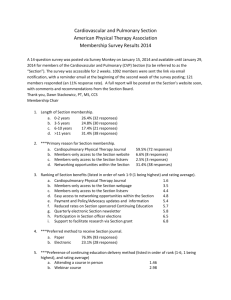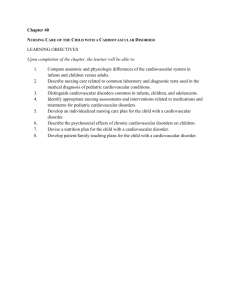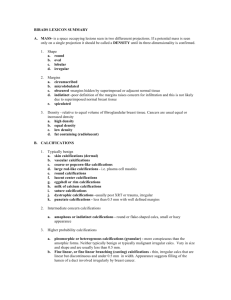Online data supplement: Methods - Springer Static Content Server
advertisement
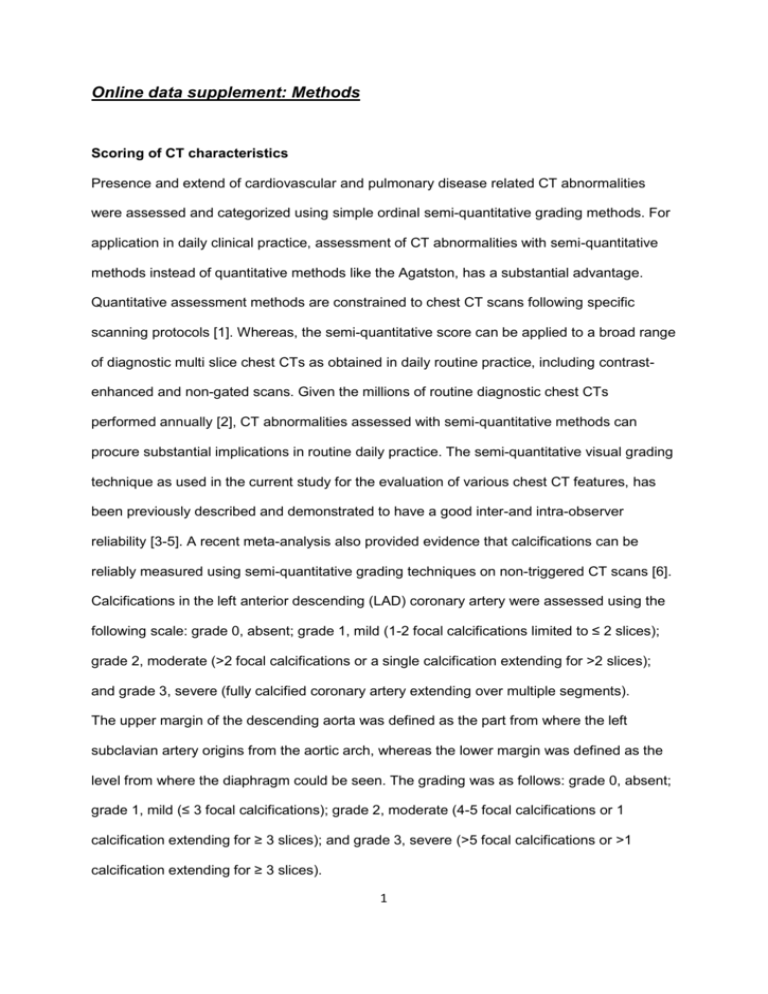
Online data supplement: Methods Scoring of CT characteristics Presence and extend of cardiovascular and pulmonary disease related CT abnormalities were assessed and categorized using simple ordinal semi-quantitative grading methods. For application in daily clinical practice, assessment of CT abnormalities with semi-quantitative methods instead of quantitative methods like the Agatston, has a substantial advantage. Quantitative assessment methods are constrained to chest CT scans following specific scanning protocols [1]. Whereas, the semi-quantitative score can be applied to a broad range of diagnostic multi slice chest CTs as obtained in daily routine practice, including contrastenhanced and non-gated scans. Given the millions of routine diagnostic chest CTs performed annually [2], CT abnormalities assessed with semi-quantitative methods can procure substantial implications in routine daily practice. The semi-quantitative visual grading technique as used in the current study for the evaluation of various chest CT features, has been previously described and demonstrated to have a good inter-and intra-observer reliability [3-5]. A recent meta-analysis also provided evidence that calcifications can be reliably measured using semi-quantitative grading techniques on non-triggered CT scans [6]. Calcifications in the left anterior descending (LAD) coronary artery were assessed using the following scale: grade 0, absent; grade 1, mild (1-2 focal calcifications limited to ≤ 2 slices); grade 2, moderate (>2 focal calcifications or a single calcification extending for >2 slices); and grade 3, severe (fully calcified coronary artery extending over multiple segments). The upper margin of the descending aorta was defined as the part from where the left subclavian artery origins from the aortic arch, whereas the lower margin was defined as the level from where the diaphragm could be seen. The grading was as follows: grade 0, absent; grade 1, mild (≤ 3 focal calcifications); grade 2, moderate (4-5 focal calcifications or 1 calcification extending for ≥ 3 slices); and grade 3, severe (>5 focal calcifications or >1 calcification extending for ≥ 3 slices). 1 Mitral valve leaflet calcifications were graded as follows: grade 0, absent; grade 1, mild (one single affected leaflet [spotty or linear calcifications]); grade 2, moderate (two affected leaflets [spotty or linear calcifications]). The cardiac diameter was measured at the point where the transverse cardiac silhouette reached its maximum. The cardiac diameter was measured using a measurement function, implemented in the DICOM reviewing software. Scoring of pulmonary abnormalities was performed at a research workstation (iXViewer; Image Sciences Institute). Abnormalities were defined according to the Fleischner Society criteria [7]. Airway thickening, ground glass and consolidation were scored as absent or present for each of the five pulmonary lobes. Pleural effusion was assessed on axial images by measuring the fluid layer on the left and right side in cm. The largest lymph node on the axial image was measured. Measurements were performed using a measurement function, implemented in the DICOM reviewing software. For airway thickening, ground glass and consolidation a total score of the five pulmonary lobes of 1 was defined as mild, score 2 as moderate and score 3 and higher as severe disease. For pleural effusion a sum score of the fluid layers on the left and right side of < 6 cm was defined as mild, 6-12 cm was defined as moderate and > 12 cm as severe. For lymph node diameter a short axis diameter between 6 and 10-mm was defined as mild and greater than 10-mm as moderate disease. In routine clinical practice lymph nodes <10-mm are seen as normal, but we argued that these small lymph nodes may still be predictive for cardiovascular disease. CT scorings were performed by research physicians with 3 years of experience in reading chest CT and one board certified radiologist. The reader was blinded for participant’s characteristics and outcome status. A random set of 50 examinations, enriched with abnormalities were scored by the radiologist and research physicians. Observer agreement was good for coronary calcifications (kappa 0.77), aortic calcifications (kappa 0.72), lymphadenopathy (ICC 0.93) and pleural effusion (kappa 0.81), moderate for mitral valve 2 calcifications (kappa 0.58) and fair for consolidations (kappa 0.36), ground glass (kappa 0.37) and airway thickening (kappa 0.33). Follow up and cardiovascular events Data on fatal and non-fatal CVD events were obtained from the Dutch National Registry of Hospital Discharge Diagnoses (ICD-9 codes 390 to 459) and the National Death Registry (codes ICD-10 codes I00-I99) from baseline to January 2008. Using the ICD-9 codes, we categorized CVD events as coronary events (codes 410 to 414), cerebrovascular events (codes 430-438) or other cardiovascular disease (codes 401–405, 420–429, 440–449). Using the ICD-10 codes, we categorized cardiovascular deaths as coronary heart deaths (codes I20-I25), cerebrovascular death (codes I60-I69) or death due to other cardiovascular disease (codes I30–I52, I70–I79, R00–R09) [8]. The database was linked to the study cohort with a validated probabilistic method [9,10]. As previously demonstrated, the overall quality of Dutch national registers is high and ICDcodes have high sensitivities and positive predictive values [11,12], enabling reliable identification of cases and follow-up. For each patient we determined an entry date, which was the date subjects underwent chest CT. In addition, we determined the censor date, which was the earliest date of the dates on which they developed outcome of interest, date the study period ended (1 January 2009) or date of death. Whenever multiple events occurred, the first event was taken as an end point. We determined the person years at risk; the difference between the entry date and the censor date. 3 Statistical analyses Association analysis Associations of the five pulmonary disease related CT findings and disease endpoints were investigated using Cox proportional hazard models with an estimation procedure adapted for the case-cohort design according to Prentice [13]. Two series of cox models were built; the first model adjusted for age and gender; the second adjusted for age, gender, CT indication, left anterior descending coronary calcifications, mitral valve calcifications and descending aorta calcifications and cardiac diameter. Forward stepwise procedure for cardio-pulmonary CT features model derivation A Cox proportional hazard model including limited patient characteristics and only cardiovascular CT findings was pre-specified. This model will further be referred to as the “cardiovascular CT features model” and comprised the following predictors: age, gender, CT indication, LAD coronary artery calcifications, mitral valve calcifications and descending aorta calcifications and cardiac diameter. Subsequently, the “cardio-pulmonary CT features model” was derived, consisting of the predictors included in the cardiovascular CT features model plus a selection of pulmonary disease related CT findings. First, each pulmonary disease related CT finding was added separately to the cardiovascular CT features model. Pulmonary disease related CT finding that provided a significantly better model fit when added to the cardiovascular CT features model as measured by the likelihood ratio test were selected. The magnitude of the likelihood ratio Chi-Square value determined the order in which pulmonary disease related CT findings were entered in the cardiovascular CT features based model. Addition of variables to the cardiovascular CT features based model was stopped when admission of candidate variables did no longer significantly improved model fit, as indicated by a nonsignificant likelihood Chi-square (P value > 0.05). 4 Discrimination and reclassification The incremental prognostic value of pulmonary disease related CT findings in CVD event risk prediction was assessed by comparing discrimination and reclassification of the cardiovascular CT features model and cardio-pulmonary CT features model. Discriminative ability of the models was examined by calculating the bootstrap corrected C-statistic using 150 repetitions. The bootstrap method was used to correct for over-optimism of the fitted models [14]. Next, reclassification percentages were computed to study the incremental ability of the composite pulmonary, mediastinal and pleural findings to classify subjects in 5-year risk categories of low (<5%), intermediate (5–10%), and high risk (>10%) [15]. To evaluate true improvement in classification by addition of pulmonary, mediastinal and pleural findings to cardiovascular CT features model, the net reclassification improvement (NRI) was calculated [16]. Measures were reweighted to reflect the distribution in the overall cohort. 5 Online data supplement: Results Based on the likelihood ratio statistic tests ground glass (χ2 92.9 , P<0.001), lymph node diameter (χ2 44.2, P<0.001), pleural effusion (χ2 33.5, P<0.001), and consolidation (χ2 9.3, P<0.03) significantly improved model fit when separately added to the cardiovascular CT features based model. The magnitude of the χ2 statistics indicate that, after ground glass, lymph node diameter provided the best model fit, followed by pleural effusion and consolidation. In the forward procedure used for derivation of the cardio-pulmonary CT features model, ground glass entered first because it provided the best model fit. Subsequently, the variables lymph node diameter and pleural effusion were entered to the model. Addition of consolidation no longer improved model fit (likelihood Chi-square = 6.04, P = 0.11), so the final cardio-pulmonary CT features model included age, gender, CT indication, left anterior descending coronary, mitral valve and descending aorta calcifications and cardiac diameter plus ground glass, lymph node diameter and pleural effusion. 6 Reference list 1. Agatston AS, Janowitz WR, Hildner FJ, Zusmer NR, Viamonte M, Jr., et al. (1990) Quantification of coronary artery calcium using ultrafast computed tomography. J Am Coll Cardiol 15: 827-832. 2. Brenner DJ (2012) Radiation and chest CT scans: are there problems? What should we do? Chest 142: 549-550. 3. Jacobs PC, Prokop M, Oen AL, van der Graaf Y, Grobbee DE, et al. (2010) Semiquantitative assessment of cardiovascular disease markers in multislice computed tomography of the chest: interobserver and intraobserver agreements. J Comput Assist Tomogr 34: 279-284. 4. Gondrie MJ, van der Graaf Y, Jacobs PC, Oen AL, Mali WP (2011) The association of incidentally detected heart valve calcification with future cardiovascular events. Eur Radiol 21: 963-973. 5. de Jong PA, Gondrie MJ, Buckens CF, Jacobs PC, Mali WP, et al. (2011) Prediction of cardiovascular events by using non-vascular findings on routine chest CT. PLoS One 6: e26036. 6. Xie X, Zhao Y, de Bock GH, de Jong PA, Mali WP, et al. (2013) Validation and prognosis of coronary artery calcium scoring in nontriggered thoracic computed tomography: systematic review and meta-analysis. Circ Cardiovasc Imaging 6: 514-521. 7. Hansell DM, Bankier AA, MacMahon H, McLoud TC, Muller NL, et al. (2008) Fleischner Society: glossary of terms for thoracic imaging. Radiology 246: 697-722. 8. World Health Organization (2010) International Statistical Classification of Diseases and Related Health Problems 10th Revision. 9. Paas GR VK (2002) Research on the validity of the LMR. 10. Bruin de AK, J.W.; Gast, A.; Bruin, E.; Sijl van, M.; Verweij, G.; (2004) Record linkage of hospital discharge register with population register: experiences at Statistics Netherlands. Stat J UN Econ Comm Eur: 23-32. 11. Mackenbach JP, van Duyne WM (1984) [Registration and coding of various causes of death in the Netherlands and other EEC countries]. Ned Tijdschr Geneeskd 128: 13-18. 12. Merry AH, Boer JM, Schouten LJ, Feskens EJ, Verschuren WM, et al. (2009) Validity of coronary heart diseases and heart failure based on hospital discharge and mortality data in the Netherlands using the cardiovascular registry Maastricht cohort study. Eur J Epidemiol 24: 237-247. 13. Prentice RL, Self SG (1988) Aspects of the use of relative risk models in the design and analysis of cohort studies and prevention trials. Stat Med 7: 275-287. 14. Harrell FE, Jr. (2001) Regression Modeling Strategies: With Application to Linear Models, Logistic Regression, and Survival Analysis.: New York Springer Publishing. 15. (2002) Third Report of the National Cholesterol Education Program (NCEP) Expert Panel on Detection, Evaluation, and Treatment of High Blood Cholesterol in Adults (Adult Treatment Panel III) final report. Circulation 106: 3143-3421. 16. Steyerberg EW, Pencina MJ, Lingsma HF, Kattan MW, Vickers AJ, et al. (2012) Assessing the incremental value of diagnostic and prognostic markers: a review and illustration. Eur J Clin Invest 42: 216-228. 7






